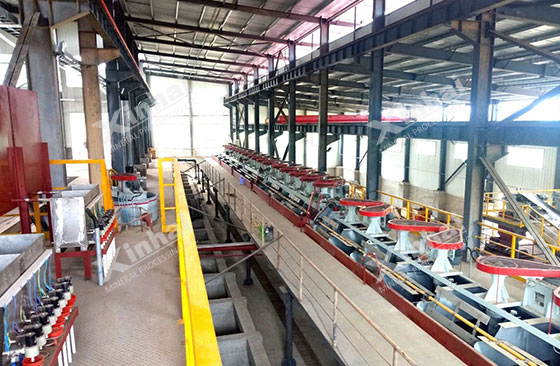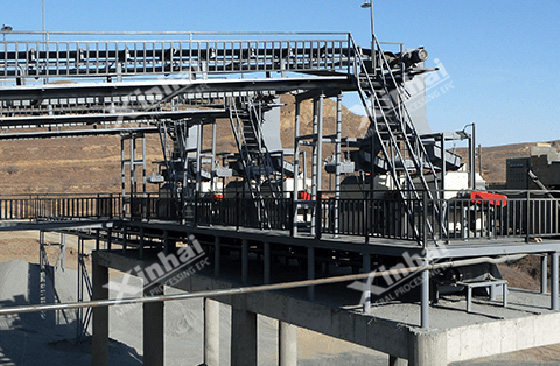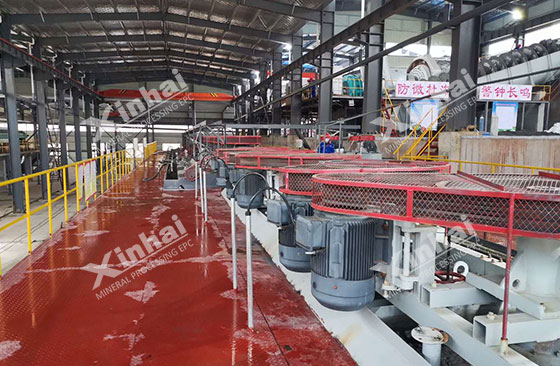Tantalum and niobium are rare metals with high melting points. They are widely used in the manufacture of rockets, spacecraft, satellites, micro-capacitors, computer memory devices and superconducting alloys due to their excellent properties such as high strength, fatigue resistance, corrosion resistance, good conductivity and large thermal expansion coefficient. With the continuous mining of mineral resources, it is imperative to rationally develop rare metal mineral resources such as tantalum and niobium. Choosing a suitable ore dressing technology is an important part of utilizing mineral resources. The characteristics of rare metal ores, the content of valuable components in the original ore and the mineral composition will affect the selection of tantalum and niobium ore dressing technology.

At present, tantalum-niobium ore dressing can be carried out by gravity separation, magnetic separation, electrostatic separation, flotation + gravity separation, flotation + chemical treatment and other beneficiation methods. Among them, the complete beneficiation method can be divided into two parts: roughing and concentrating. The roughing of tantalum-niobium ore mainly adopts the gravity separation process, or the magnetic separation + flotation combined process, and a low-grade mixed rough concentrate is obtained after roughing. Due to the complex composition of the rough concentrate, sorting is more difficult. For the concentrating of tantalum-niobium ore, one, two or more combined methods of magnetic separation, gravity separation, flotation, electrostatic separation, chemical treatment and other methods are required, so that a variety of useful minerals can be effectively separated.
Use the table of contents below to navigate through the guide:
01Gravity separation for tantalum-niobium ore dressing
The density of valuable minerals in tantalum-niobium ore is generally above 4t/m³, so it is most appropriate to use gravity separation technology to treat this type of ore. Different gravity separation equipment is selected for tantalum-niobium ores of different fineness. Coarse-grained tantalum-niobium iron ore is roughly separated by jig, spiral concentrator or spiral chute, and then the coarse concentrate is finely separated by shaking table. For fine-grained tantalum-niobium iron ore, spiral chute or shaking table is generally used for rough separation, and the concentrate obtained by rough separation is finely separated by shaking table. Tantalum-niobium ore slime is roughly separated by centrifugal separation equipment or multi-layer multi-stage turning bed equipment, while the belt chute combined with the ore slime shaking table is used for fine separation.

Gravity separation process features:
1. The stage grinding and multi-stage gravity separation process are implemented to avoid over-crushing of useful components as much as possible.
2. Before using the shaking table for gravity separation, the material needs to be classified first so as to recover the monomer dissociated minerals as soon as possible.
Although the gravity separation method for tantalum-niobium ore has low investment and low cost, the separation efficiency of ore slime is relatively low.
02Flotation separation for Tantalum-niobium ore dressing
When flotation is used to treat tantalum-niobium ore slime, it is often combined with gravity separation technology to reduce the loss of tantalum-niobium ore in the slime and improve the grade of tantalum-niobium concentrate. Before flotation of tantalum-niobium ore, a small-diameter cyclone or centrifugal concentrator is required for desludging. Although the flotation separation index is relatively high, its reagent consumption is relatively large, resulting in a relatively high production cost.

Flotation plays a key role in the separation of tantalum-niobium concentrate, and efficient separation can be achieved through the combination of different reagents. When flotating monazite and separating tantalite, oleic acid is often used as a collector, sodium carbonate as a regulator, and sodium silicate and sodium sulfide as inhibitors. For the separation of cassiterite, alkyl sodium sulfate is used as a collector and sodium fluorosilicate as a inhibitor to effectively separate fine crystal stone from cassiterite in an acidic environment. When separating niobium iron ore and zircon, sodium oleate is used as a collector, combined with regulators such as lead chloride, water glass or oxalic acid to further improve the separation effect.
03Magnetic separation for Tantalum-niobium ore dressing
Tantalum-niobium ore is magnetic. According to the different specific magnetic susceptibilities of tantalite, columbite, garnet, tourmaline and other minerals, the magnetic induction intensity of the magnetic field can be adjusted to separate them, thereby obtaining niobium concentrate. In order to improve the separation effect, it is usually treated with acid for a short time to remove the iron on the surface of the mineral. In addition, tantalite and columbite can also be separated from non-magnetic cassiterite by magnetic separation.

04Electrostatic separation for Tantalum-niobium ore dressing
Tantalum and columbite must be separated from garnet by first narrow particle screening and grading, then heated and electrostatically separated in a composite electric field. Coarse-grained ores are usually separated using low voltage, large pole distance and slow rotation speed, while fine-grained ores are separated using high voltage, small pole distance and fast rotation speed. In this way, tantalite, columbite and garnet can be effectively separated.

In summary, the ore dressing process of tantalum-niobium ore is reasonably selected according to the properties of the ore and the mineral composition. Whether it is gravity separation, magnetic separation, flotation or electrostatic separation, each method has its unique advantages and application scenarios. By reasonably combining these process flows, not only can the recovery rate of tantalum-niobium ore be improved, but also the difficult-to-select minerals can be effectively separated and the quality of the concentrate can be improved. In the future, with the continuous advancement of technology, the beneficiation process of tantalum-niobium ore will be more perfect, providing a solid guarantee for the efficient utilization of rare metal resources.


 marketing@ytxinhai.com
marketing@ytxinhai.com  0086 13810327080
0086 13810327080 






































































































 CHAT
CHAT MESSAGE
MESSAGE





